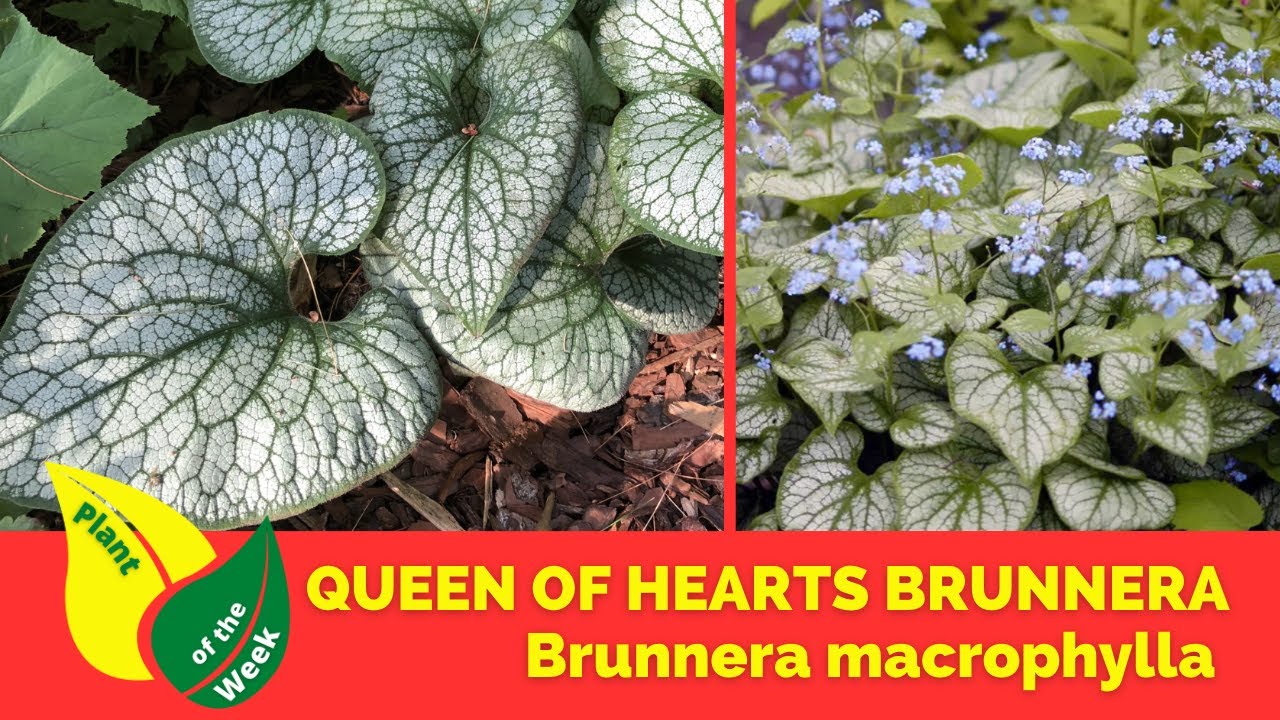‘Queen of Hearts’ is a popular variety of heartleaf brunnera featuring silver-frosted leaves veined in deep green and forget-me-not-like blue flowers in spring. This carefree perennial thrives in shady spots, is deer and rabbit resistant, and adds striking foliage contrast to the garden. Read on for tips on successfully growing and caring for ‘Queen of Hearts’ brunnera.
Overview of ‘Queen of Hearts’ Brunnera
‘Queen of Hearts’ is a patented variety of Brunnera macrophylla bred by Terra Nova Nurseries. Some key facts about this brunnera variety:
-
Grows 16-18 inches tall and spreads 28-36 inches wide.
-
Leaves are heart-shaped with silver overlay and dark green veining
-
Sprays of baby blue flowers in spring resemble forget-me-nots,
-
Performs best in part shade to full shade.
-
Deer and rabbit resistant.
-
Hardy in zones 3-8.
-
Low maintenance and tolerates a range of soil conditions.
How to Grow ‘Queen of Hearts’ Brunnera
SITE SELECTION
When choosing a spot to plant ‘Queen of Hearts’ brunnera, opt for an area with partial shade or filtered sunlight. While this plant tolerates full shade, it will produce the most blooms and best leaf coloring with a few hours of morning or late afternoon sun. Shelter it from hot midday sun which can scorch the foliage.
Well-drained, humus-rich soil amended with compost is ideal. However, ‘Queen of Hearts’ is adaptable to most soil types, including heavy clay, as long as the drainage is decent. Just avoid overly wet sites. This brunnera will even naturalize in woodland settings.
PLANTING
Plant ‘Queen of Hearts’ brunnera in spring once the threat of hard frost has passed. Space plants 2-3 feet apart to allow for mature spread. Dig a hole twice the width of the root ball and backfill with the native soil. Water thoroughly after planting. Apply a 2-3 inch layer of shredded bark mulch around plants to help retain soil moisture and suppress weeds.
CARE
‘Queen of Hearts’ requires minimal care once established. Top dress plants with fresh compost or slow-release fertilizer in early spring. This brunnera is quite drought tolerant, but occasional deep watering during dry periods will keep it looking its best. Prune off any damaged foliage as needed.
Remove spent flower stems down to the base after blooming finishes. Cut foliage back to the ground in late fall in climates with harsh winters. In mild winter areas, old and new leaves may remain evergreen.
DIVIDING
Mature clumps can be divided every 2-3 years in early spring. Use a sharp spade to slice through the plant, ensuring each division has plenty of roots. Replant divisions and water well.
Troubleshooting ‘Queen of Hearts’ Brunnera
PREVENTING LEAF SCORCH
Leaf scorch shows up as brown crispy edges and is caused by too much sun or heat. Ensure ‘Queen of Hearts’ is situated in light to medium shade. Water during periods of drought to keep leaves hydrated.
CONTROLLING PESTS
Slugs and snails may feed on the foliage, particularly in moist environments. Use organic slug bait as needed to protect plants. Spider mites can sometimes be a problem during hot, dry weather. Knock them off with a strong jet of water or use insecticidal soap.
AVOIDING CROWN ROT
Crown rot can occur in poorly drained sites, especially over winter. Improve drainage before planting. Space plants to allow air circulation. Apply mulch that doesn’t stay wet against the crown. Avoid excessive watering.
FIXING POOR FLOWERING
Insufficient sunlight, overcrowding, overfertilization, or pruning at the wrong time can limit flowering. Give plants the sunniest site possible and divide congested clumps. Refrain from high nitrogen fertilizer and late summer pruning.
Ideal Companion Plants for ‘Queen of Hearts’
Here are some great options for plants that pair beautifully with ‘Queen of Hearts’ brunnera:
-
Hostas – combine various hosta varieties with contrasting leaf shapes, sizes, and colors.
-
Ferns – astilbe, maidenhair, Christmas fern, etc. Textural contrast.
-
Coral bells (Heuchera) – purple-leaved varieties like ‘Plum Pudding’ create nice contrast.
-
Foamflower (Tiarella) – short-statured perennials with spikes of flowers.
-
Lungworts (Pulmonaria) – colorful, spotted foliage.
-
Caladium – bright leaf colors and patterns to mix with silver leaves.
-
Hellebores – early blooming with nodding flowers in shades of white, pink, purple.
-
Carex – contrasting grassy texture. Evergreen in mild climates.
Why Grow ‘Queen of Hearts’ Brunnera
Here are just some of the reasons this variety is a must-have perennial for shady gardens:
-
Striking silver frosted and veined foliage provides color and contrast.
-
Forget-me-not-like blue blooms in spring.
-
Spreads nicely to form a lush groundcover layer without being aggressive.
-
Adds texture, contrast, and visual interest to shady beds and borders.
-
Tolerates a wide range of conditions including dry shade once established.
-
Deer and rabbit resistant – rarely bothered by animal pests.
-
Easy care perennial, just trim off spent blooms.
-
Works beautifully in containers paired with shade annuals.
For gardeners seeking an eye-catching but low maintenance perennial that thrives in shady planting sites, ‘Queen of Hearts’ brunnera is sure to become a treasured addition to your collection!
QUEEN OF HEARTS BRUNNERA | Brunnera macrophylla | Inspiration for Your Garden
FAQ
How do you take care of a Queen of Hearts plant?
Is Queen of Hearts a perennial?
- A Complete Guide to Caring for Yuki Cherry Blossom Shrub - January 23, 2025
- Identifying Red Hot Poker Seeds: What to Look For When Harvesting Torch Lily Pods - January 23, 2025
- A Complete Guide to Harvesting Evening Primrose Seeds - January 23, 2025

